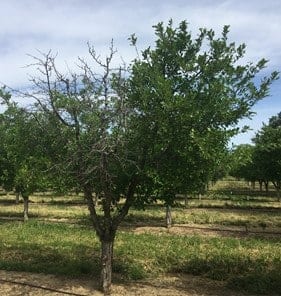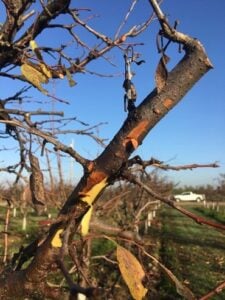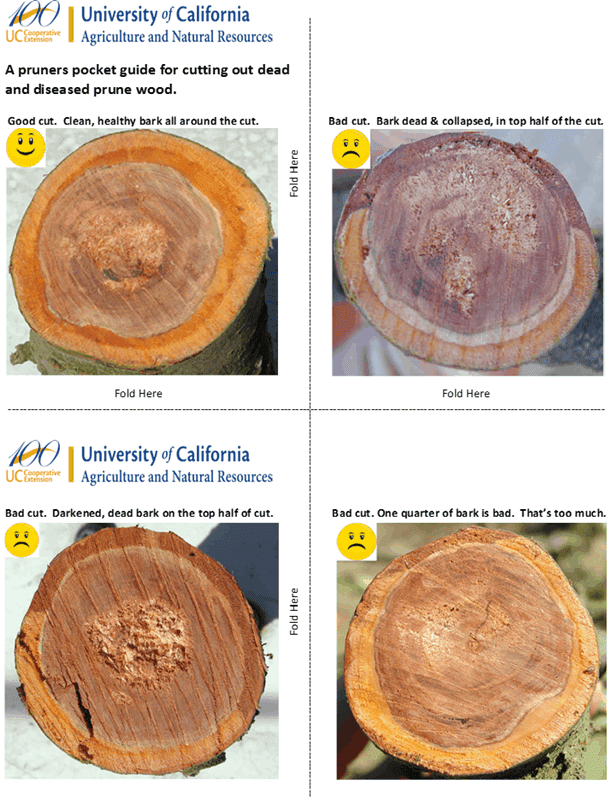Orchard Notes: November 2021
Table of Contents
2022 PMC and CPB Elections
Fall Orchard Considerations
Three Steps to Combat Cytospora Canker
Prune Orchard Investments in a Better Market Year
Upcoming Events
CPB & PMC Election 2022 is coming soon!
Eligible independent growers, watch your email and your postal mailbox for information on nomination meetings and election details! If you don’t receive information and think you should, please contact Becky at bpoland@californiaprunes.org.
Fall Prune Orchard Management Considerations
Clarissa Reyes, North Sacramento Valley Orchard System Staff Research Associate
Prune to remove Cytospora and to manage next year’s crop:
- Remove existing cytospora cankers and spore sources by cutting branches several inches to a foot below the symptoms and burn prunings (if permitted).
- Consider your management goals: topping young vigorous trees before a big wind can reduce the risk of blow-over, while long pruning can increase early yields in young prune plantings.
- Prune early in the fall to allow cuts to harden off before seasonal rains. Protect fresh wounds from water-borne spores with a fungicide spray (Topsin-M® or Topsin-M® + Rally®).
Sanitize your orchard by removing fruit mummies and blighted shoots to remove disease inoculum. Remove bark damaged during harvest, and backhoe out diseased or dead trees to prepare for replants.
Irrigate to maintain mild to moderate water stress post-harvest. Stem water potential should be between -12 and -16 bars as measured by a pressure chamber. Avoid high water stress levels as Cytospora spreads faster in stressed trees compared to adequately watered trees.
Take soil samples to check soil salinity and toxic salt (chloride, sodium, and/or boron) levels going into what could be a dry winter. This is especially important for newer orchards on Krymsk 86 rootstock, which is more sensitive to chloride than Marianna or Myro. UC ANR provides a free video series on soil sampling.
Band potassium (K) in the soil, based on July leaf sample results, visual symptoms, and the amount of fruit harvested this year.
Apply foliar zinc (Zn) to correct zinc deficiency (July leaf sample <18ppm). Spraying 20 lbs/acre of 36% zinc sulfate as natural leaf drop begins in late October can deliver needed zinc into the tree and, in addition, can facilitate leaf drop, reducing the risk of blow over and/or disrupting aphid reproduction.
Plant new trees. Protect trees from sunburn and herbicides with white interior latex paint diluted 2:1 water to paint, plus tree wraps. If tree wraps are used without painting trees, the boxes should be flattened (◊ from the top, not □) to avoid “wrapper burn.” Research in almonds shows that white paint, alone, doesn’t protect young tree trunks from herbicide damage.
Check irrigation system for uniform distribution to prepare for heat or frost protection during bloom.
Survey for weeds after the first rain to identify perennials, germinating winter annuals, and summer species that escaped the past season’s control tactics to inform next year’s control strategies. UC IPM provides a printable weed survey form (PDF).
Manage gophers when populations are at their lowest. Trapping, fumigation, and baiting can all be effectively utilized when soil is moist.
Sample dormant spurs to determine pest management needs for aphids, mites, and scale pests.
- Aphid: If you have a history of aphid infestations, assume you have an annual problem and treat aphids between fall and leaf out.
- San Jose Scale: Treat with oil, or for moderate to high infestations, oil with insect growth regulator (Centaur®, SeizeTM). Check with your PCA about using oil if the trees and/or soil are dry to avoid oil burn damage, especially to young shoots.
Peach Twig Borer (PTB): PTB can infest prunes. Dormant sprays of oil plus spinetoram (Delegate®), spinosad (EntrustTM, SuccessTM), or diflubenzuron (Dimilin®) will kill overwintering larvae without causing water quality issues—oil alone does not control peach twig borer. Managing PTB is part of a fruit brown rot control program as skin damage from worm feeding provides an avenue for disease infection.
Three Steps to Combat Cytospora Canker
Luke Milliron, UCCE Farm Advisor Butte, Glenn, and Tehama Counties
Franz Niederholzer, UCCE Farm Advisor Colusa, Sutter, and Yuba Counties
 Cankers caused by fungi of Cytospora spp. can severely limit prune production; reducing grower income and potentially leading to early orchard removal due to scaffold and/or tree loss (see Photo 1). In recent years there has been a dramatic increase in this disease in some orchards. Because the disease is widespread and infections persist year-after-year, integrated Cytospora management needs to be part of every prune grower and PCAs activities each year.
Cankers caused by fungi of Cytospora spp. can severely limit prune production; reducing grower income and potentially leading to early orchard removal due to scaffold and/or tree loss (see Photo 1). In recent years there has been a dramatic increase in this disease in some orchards. Because the disease is widespread and infections persist year-after-year, integrated Cytospora management needs to be part of every prune grower and PCAs activities each year.
- Protect pruning wounds.
Problem: Rain and wind splashed spores can infect unprotected pruning wounds. Infections can occur anytime rain occurs, wounds are open and disease spores are present. However, the first good rainstorm of the season may produce an especially large spore release, as the spores build up in diseased wood over time and cannot be released without rain.
Solution: Pruning wounds are vulnerable to infection for at least 30 days after the cuts were made, although the vulnerability is greatest in the first 15 days after pruning. Fieldwork has documented that 1Topsin®-M fungicide (now with a 2EE label for pruning wound protection), applied directly to pruning wounds within a week of pruning, can reduce canker incidence. To date, other fungicides tested have not delivered the same, consistent results as Topsin®-M.
- Cut out diseased wood.
Problem: Unless it’s cut out, Cytospora cankers can continue to kill the infected tree with canker growth year after year. As an insult to injury, existing cankers also spread the disease to new trees by producing spores that will be rain and wind splashed in the next big storm event.
 Solution: The first step in stopping Cytospora spread by cutting out diseased wood begins in identifying infections (see photo 2). In addition to pruning wounds, sunburn injured bark, borer damage, and other mechanical wounds (i.e. hail, oil burn, etc.) are all among the many potential sources of infection. You can look for brown Cytospora canker lines by cutting the bark with a pocket knife (photo 2). As pruners remove dead and diseased wood – inspect cuts to ensure that they have cut clear into healthy wood, cutting the branch/shoot 2 inches below the external canker margin (figure 1). If pruners leave any canker, the canker may continue to spread in that tree and provide inoculum to infect additional trees. Of course, removing diseased wood creates new pruning wounds that could themselves become infected – which is why this is best done in summer or early fall. If there is a chance of rain in the 30 days after pruning out dead and diseased wood consider protecting pruning cuts with 1Topsin®-M fungicide (see #1 above).
Solution: The first step in stopping Cytospora spread by cutting out diseased wood begins in identifying infections (see photo 2). In addition to pruning wounds, sunburn injured bark, borer damage, and other mechanical wounds (i.e. hail, oil burn, etc.) are all among the many potential sources of infection. You can look for brown Cytospora canker lines by cutting the bark with a pocket knife (photo 2). As pruners remove dead and diseased wood – inspect cuts to ensure that they have cut clear into healthy wood, cutting the branch/shoot 2 inches below the external canker margin (figure 1). If pruners leave any canker, the canker may continue to spread in that tree and provide inoculum to infect additional trees. Of course, removing diseased wood creates new pruning wounds that could themselves become infected – which is why this is best done in summer or early fall. If there is a chance of rain in the 30 days after pruning out dead and diseased wood consider protecting pruning cuts with 1Topsin®-M fungicide (see #1 above).
 Figure 1. Pruners pocket guide for cutting out dead and diseased prune wood. Pay close attention to darkened brown bark (outermost band of the cut branch) and keep cutting until the bark is healthy all around the cut.
Figure 1. Pruners pocket guide for cutting out dead and diseased prune wood. Pay close attention to darkened brown bark (outermost band of the cut branch) and keep cutting until the bark is healthy all around the cut.
- Invest in maintaining healthy trees. Cytospora preys on the weak.
Problem: Stressed prune trees are more susceptible to Cytospora canker infection and existing cankers will spread more rapidly in stressed trees. Whether because of tough economics, drought, or other factors – it’s easy for trees to become stressed and predisposed to Cytospora canker infection and spread. Specifically, the lab of Dr. Themis Michailides (UC Davis Plant Pathologist) has shown that cankers spread fastest in severely drought-stressed trees. Water stress, potassium deficiency, mites, aphids, and rust can all lead to defoliation which allows for sunburn, another potential entry for Cytospora canker. Finally, weaker trees are more prone to borers and other wood-attacking insects that create additional entry points for the disease.
Solution: Adequate orchard soil moisture in late summer and early fall is one of the main ways to invest in maintaining healthy trees. One key practice to achieve this is taking stem water potential (SWP) readings with a pressure chamber to avoid the canker spread inducing severe water stress in late summer and early fall. Post-harvest irrigation should recover the trees to mild- to moderate-stress (-12 to -16 bars SWP) to not reduce photosynthesis and disrupt carbohydrate allocation to storage leading to overwintering. An alternative to the pressure chamber is soil moisture sensors.
A second way to invest in healthy trees is to not skimp on potassium (K) fertilizer. Maintain regular drip fertigation or fall banded program based on a combination of July leaf sample results, visual symptoms, and the amount of fruit harvested this year. Alternatively, a ground applied K program can also be supplemented with foliar applied potassium nitrate (KNO3) in spring and early summer. Prune newsletter orchard tasks published in each issue detail other key best practices for each season of the year that limit tree stress and defoliation and make for a healthier and more resilient orchard.
Prune Orchard Investments in a Better Market Year
Franz Niederholzer, UCCE Farm Advisor, Colusa and Sutter/Yuba Counties
Prune prices to California growers are influenced by world production volume that can change, dramatically, from year to year. For example, in 2013 world prune volume declined by 47,000 tons (17%) when production in France, Chile, and California was reduced by bad weather. In 2014, Argentina was hit with unfavorable weather leading to a further 4% (7,000 tons) reduction in world market volume despite production increases in California, Chile, and France. Coincident with these changes in world prune volume, CDFA reports show an increase in average price to growers from $1330/ton (2012) to $2470/ton (2014). In 2015, world prune volume increased by 40,000 tons (18%) over 2014 levels and average prices to California growers decreased to roughly $2000/ton and have hovered at or below that price since then as world production has not experienced dramatic swings.
The 2021 prune crop in California appears to be in a good position in the world market due to a solid crop at home and bad weather in major prune exporting countries (Chile, Argentina, and France) which reduced world production volume by around 50,000 tons from expected levels. While rising labor and shipping costs may dampen possible price increases, now might be a time for growers to consider investments in practices and/or equipment that can help improve or sustain future production. If history is any indication, world production may rebound quickly.
Pruning. Good pruners are hard to find and the cost of pruning is very high. However, if part of an orchard could be cleaned up with some detailed pruning (best) or even just a few big cuts made for light and deadwood removal (OK) better production and orchard health could be sustained. In particular, cutting out cytospora infected large wood with a small, trained crew using “chain saws on a pole” could be especially valuable (see article on Cytospora canker in this newsletter). If not cut out, this damaging disease will continue to grow and reduce yield in infected trees and be a source of infection to other trees. A free Pocket Pruner’s Guide to Cutting out Cytospora is available online and in this newsletter to help pruners recognize when the disease has been completely removed from a branch. If all the disease isn’t cut out, the job isn’t done. Spraying the orchard with Topsin®-M fungicide after pruning or cutting is another investment in long-term orchard health as damaging diseases and wood rots enter the tree through those cuts if not protected ahead of the rain.
Irrigation. The 2022 season may be especially challenging if decent to excellent levels of rain (and snow) don’t fall. A thorough checkup of your well, pump, and irrigation system may be in order, especially if system testing has been deferred. A pump test will identify possible major problems such as substantial pressure reductions or water flow rates. Learn how to monitor standing and pumping groundwater levels to track changes in groundwater conditions. Check the Well Completion Report for your well. This site will provide information regarding the well conditions after drilling, submitted by the driller as required by regulation. Find out how deep your pump bowls are relative to the pumping water depth. Bowl depth information may have been moved since the well was first completed, so check maintenance/repair records. Thoroughly check filters, pressure gauges, screens, and lines to make sure there are no plugs or leaks. Finally, there is no better tool to check orchard water status than a pressure chamber. For a one-time investment of around $1500-4500, you will have the means of knowing your tree’s water status and how your irrigation program is working at any point in time.
Potassium. This essential nutrient is expensive and growers may have been shaving application rates to help make ends meet. A full maintenance rate of 400-500 lbs. of potassium sulfate (SOP) per acre should help reload the “potassium bank” in the orchard root zone this winter. (This assumes that enough rain will fall to dissolve the material and move it into the soil.) Winter irrigation may be needed (to manage salts, ease orchard water stress, and/or incorporate fertilizer) if adequate rainfall doesn’t occur, so make sure the fertilizer is applied ahead of that irrigation water. The argument for the fall application of dry material is that it is less expensive than in-season options (see next paragraph) and can be applied in a relative down-time.
Potassium may also be applied during the growing season as foliar potassium nitrate sprays and/or by injecting liquid potassium through the drip or micro-sprinkler system. However, these materials are usually more expensive per unit of applied potassium than dry SOP applied in the fall. They are effective if enough potassium is applied to meet crop needs. The advantage of these injected or sprayed materials is that crop load, and therefore potassium need can be checked before expensive potassium is applied.
Upcoming Events
| Date | Meeting | Location |
| December 1-2 | Prune Research Group | UC Davis |
| December 16 | Prune Board Meeting | CA Farm Bureau |
| January 18 | Yuba/Sutter Spray Safe | Yuba/Sutter Fairgrounds |
| February 1-3 | Colusa Farm Show | Colusa County Fairgrounds |
| February 8-10 | World Ag Expo | Tulare, CA |
| February 24 | Tehama Co Prune Day | Elk’s Lodge, Red Bluff |
| March 1 | Sutter/Yuba Prune meeting | Sutter Co Ag Building, Yuba City |
View Prune Board meetings and events here.
Sacramento Valley Tree Crop IPM Webinar
November 4 @ 7:30 am – 11:00 am
This is a webinar for anyone directly involved with pest and disease management in orchard production. We will discuss pest and disease issues including NOW management, mites management, wood cankers, and other pests.
Event Agenda
7:30-8:30 am Navel orangeworm and spider mites in almond and walnut, David Haviland, UCCE Kern County
8:30-9:00 am Ag Commissioner Update, Marcie Skelton, Glenn Co Ag Commissioner
9:10-9:40 am Quick review of pest management issues ahead of 2022 season, Roger Baldwin, UC Davis, Luke Milliron, UCCE, Franz Niederholzer, UCCE
9:40-10:10 am Differences in managing Bot Canker and Blight of Walnut from Band Canker of Almond, Themis Michailides, UC Davis
10:10-10:40am Almond wood canker, Florent Trouillas, UC ANR
Register at: sacvalleyorchards.com/event/sacramento-valley-tree-crop-ipm-webinar/